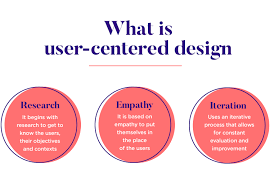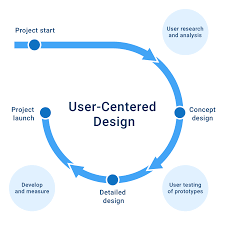Building user-centric mobile apps in the USA involves adhering to several best practices. Thorough market research is essential to understand users’ needs. This research should inform the app’s design and features. User-friendly design is paramount, with intuitive navigation and a clean layout. Performance optimization is crucial, ensuring the app runs smoothly across devices and networks. Security and data privacy are critical, requiring compliance with regulations like GDPR and HIPAA, if applicable. Ongoing updates and support are essential to keep users engaged and satisfied. Continuously gather user feedback and act on it promptly to improve the app’s quality. By following these practices, developers can create successful mobile apps that meet high standards of functionality, usability, and security in the competitive app market.
Developing user-centred mobile apps effectively requires a strategic approach that focuses on meeting user needs and expectations

Building user centric mobile apps effectively necessitates a strategic approach that prioritizes the fulfilment of user needs and expectations. This multifaceted process involves meticulous planning, thoughtful design, rigorous testing, and continuous improvement. In a world where millions of apps vying for users’ attention, crafting an exceptional user experience is imperative for success.
In-Depth User Research :
A foundational step in building user-centric mobile apps is comprehensive user research. Developers must strive to understand their target audience’s demographics, behaviours, and pain points. Surveys, interviews, and user analytics can provide invaluable insights into user preferences and expectations.
Define Clear Objectives :
Before delving into development, establish clear objectives for your mobile app. What problems will it solve for users? How will it make their lives easier or more enjoyable? Defining these goals helps maintain a user-centred focus throughout the development process.
Intuitive User Interface (UI) Design :
User-friendly design is paramount. Craft an intuitive UI that users can navigate effortlessly. Prioritize clarity, consistency, and simplicity in layout and visual elements. User testing and feedback should guide refinements in the design to ensure it aligns with users’ preferences.
Performance Optimization :
Building user-centric mobile apps must perform optimally to retain users. They should load quickly, respond swiftly to user inputs, and consume minimal device resources. Efficient coding practices, such as minimizing unnecessary data requests and optimizing images, contribute to a smoother user experience.
Data Privacy and Security :
In an era of heightened data privacy concerns, protecting user data is non-negotiable. Ensure compliance with relevant data protection regulations and implement robust security measures to safeguard user information. Transparent privacy policies build trust.
In conclusion, building user-centric mobile apps demands a holistic approach that revolves around understanding and serving users effectively. By emphasizing thorough research, intuitive design, performance optimization, data security, continuous testing, and user-focused metrics, developers can craft apps that not only attract but also retain satisfied users in a highly competitive mobile app landscape.
Creating a Mobile App: Essential Components and Considerations

1. User-Centric Approach :
Begin with a deep understanding of your target audience. Consider their needs, preferences, and pain points. Your app’s design should revolve around making their lives easier or more enjoyable.
2. Intuitive User Interface (UI) :
Craft a UI that’s intuitive and easy to navigate. Users should be able to achieve their goals within the app with minimal effort. Prioritize simplicity, consistency, and clarity in design.
3. Responsiveness and Performance :
Ensure your app performs well across various devices and network conditions. It should load quickly, respond swiftly to user interactions, and not drain excessive device resources.
4. Visual Design and Branding :
Create a visually appealing app that aligns with your brand identity. Consistent colour schemes, typography, and imagery contribute to a cohesive and memorable user experience.
5. Content Organization :
Organize content logically and ensure it’s easily accessible. Implement a clear navigation structure, use effective labelling, and consider user flow when arranging information.
6. Error Handling and Feedback :
Anticipate user errors and provide clear, helpful feedback. Users should understand what went wrong and how to correct it, reducing frustration.
7. Security and Privacy :
Prioritize data security and user privacy. Implement encryption, secure authentication, and transparent privacy policies to build trust with users.
8. Usability Testing :
Regularly conduct usability testing with real users to uncover issues and gather feedback. This iterative process ensures that your app evolves based on user needs and expectations.
9. Regular Updates and Maintenance :
Keep your app fresh and competitive by releasing updates. Address bug fixes promptly, introduce new features, and enhance existing ones based on user feedback.
10. Analytics and Metrics :
Use data analytics to track user engagement, retention, and other key metrics. Data-driven insights can inform your design decisions and overall app strategy.
Why User-Centered Design Should Be Your Focus?

1. Enhancing User Satisfaction :
Designing with users in mind ensures that your product aligns with their preferences and needs. This, in turn, leads to higher user satisfaction and a positive perception of your brand.
2. Improving Usability :
User-centered design prioritizes ease of use. When products are intuitive and straightforward, users can achieve their goals with minimal effort, reducing frustration and errors.
3. Increasing Engagement :
User-centric products tend to be more engaging. When users find an app or website tailored to their needs, they are more likely to return, explore further, and interact with the platform.
4. Reducing Development Costs :
Early user feedback and usability testing help identify and rectify design flaws before they become costly issues during development or after launch.
5. Boosting Conversion Rates :
When a design caters to users’ preferences and behaviours, it can significantly improve conversion rates, whether that means more sign-ups, purchases, or other desired actions.
6. Fostering Loyalty :
User-centered design builds trust and loyalty. When users have positive experiences, they are more likely to become loyal customers and advocates for your brand.
7. Minimizing Support and Training Needs:
Well-designed products often require less customer support and training. Users can navigate the product with ease, reducing the burden on support teams.
8. Staying Competitive:
In today’s competitive landscape, products that prioritize user needs are more likely to stand out and succeed. User-centered design can give you a significant edge.
9. Adapting to Changing Needs:
User-centered design involves ongoing feedback and improvement. This flexibility allows your product to adapt to evolving user needs and market trends.
10. Driving Innovation:
By understanding users deeply, you can identify unmet needs and opportunities for innovation, leading to groundbreaking product development.
How User-Centric Design Enhance Marketing Efforts?

1. Customer Persona Development :
In user-centred marketing, detailed customer personas are created based on thorough research. These personas represent the target audience’s characteristics, preferences, and behaviours, guiding marketing strategies.
2. Tailored Content Creation :
User-centred design helps marketers develop content that speaks directly to the needs and interests of their audience. Content is crafted to provide value and address specific pain points.
3. User Journey Mapping :
Marketers use user-centred design principles to map out the customer journey, identifying touchpoints where users interact with the brand. This allows for optimization and personalization of these interactions.
4. A/B Testing and Optimization :
User-centred marketers frequently conduct A/B testing to understand what resonates with their audience best. This data-driven approach enables continuous optimization of marketing campaigns.
5. Responsive and Accessible Design :
Websites and email campaigns are designed to be responsive and accessible on various devices and for users with disabilities, ensuring a seamless experience for all.
6. User Feedback Integration :
User-centred marketing encourages the collection of feedback through surveys, social media, and other channels. This feedback informs campaign adjustments and improvements.
7. Personalization and Segmentation :
Marketing efforts are personalized based on user data and segmentation. Tailored messages and offers are more likely to engage users and drive conversions.
8. Testing User Experience :
User experience (UX) principles are applied to marketing materials, such as landing pages and email templates, to ensure they are user-friendly and aesthetically pleasing.
9. Data-Driven Decision-Making :
User-centred marketers rely on data analytics to understand user behaviour, track campaign performance, and make informed decisions about adjustments and future strategies.
10. Customer-Centric Messaging :
Marketing messaging focuses on addressing users’ needs and conveying how the product or service can solve their specific problems or fulfil their desires.
In summary, incorporating user-centred design principles in marketing allows businesses to create more effective campaigns, resonate with their target audience, and build lasting relationships. By understanding and catering to the needs and preferences of users, marketers can enhance the impact of their marketing efforts and drive better results.
Core Principles of User-Centered Design

User-centred design (UCD) is rooted in several core principles that form the foundation for creating products and experiences that prioritize the needs and preferences of users. These principles, when applied effectively, lead to user-friendly and successful designs.
Empathize with Users :
UCD begins with a deep understanding of users. This involves conducting extensive research, engaging in user interviews, and immersing oneself in the users’ environment. By empathizing with their perspectives and needs, designers gain invaluable insights.
Define User Needs and Goals :
Clearly define the objectives and goals of the design project based on user feedback and research findings. These objectives serve as guiding principles throughout the design process.
Iterate and Prototype :
UCD emphasizes iterative design. Create prototypes and seek user feedback early and often. This iterative approach allows for quick adjustments and improvements based on user input.
Design with Clarity and Simplicity :
Keep designs simple and intuitive. Prioritize clarity in navigation and user interfaces, ensuring that users can interact with the product or system without confusion.
Test and Refine :
Continuously test the design with real users to identify issues and opportunities for enhancement. Gather feedback and use it to refine the design iteratively.
In conclusion, adhering to these core principles of User-Centered Design results in products and experiences that not only meet user expectations but also exceed them. Empathy, user-centricity, iteration, simplicity, testing, and collaboration are the cornerstones of effective UCD, ultimately leading to user satisfaction and the success of a design project.
FAQ’S
1. What is user-centric mobile app development?
User-centric mobile app development is an approach that prioritizes the needs, preferences, and expectations of the app’s target users. It involves designing and building the app with a deep understanding of the user’s perspective, aiming to create an exceptional user experience.
2. Why is user-centered design important for mobile apps in the USA?
User-centred design is essential because it ensures that mobile apps effectively address the specific needs and preferences of the American user base. By understanding and catering to these factors, mobile apps are more likely to succeed and resonate with users in the competitive USA market.
3. How can I conduct user research for my mobile app in the USA?
To conduct user research in the USA, start by defining your target audience and their demographics. Use surveys, interviews, and analytics tools to gather insights into user behaviours, preferences, and pain points. It’s crucial to understand the cultural and regional differences that may impact your app’s success in the diverse American market.
4. What are the key elements of user-friendly mobile app design?
User-friendly mobile app design includes intuitive navigation, a clean and visually appealing user interface, responsive design for various devices, and an emphasis on performance optimization. Clear content organization, efficient data handling, and accessibility features also contribute to user-friendliness.
5. How can I ensure the security and data privacy of my mobile app for users in the USA?
To secure your mobile app, follow best practices such as implementing robust encryption, secure authentication methods, and regular security audits. Ensure compliance with relevant data privacy regulations, like GDPR or HIPAA if applicable. Communicate your data handling practices in a transparent privacy policy to build trust with users.

















